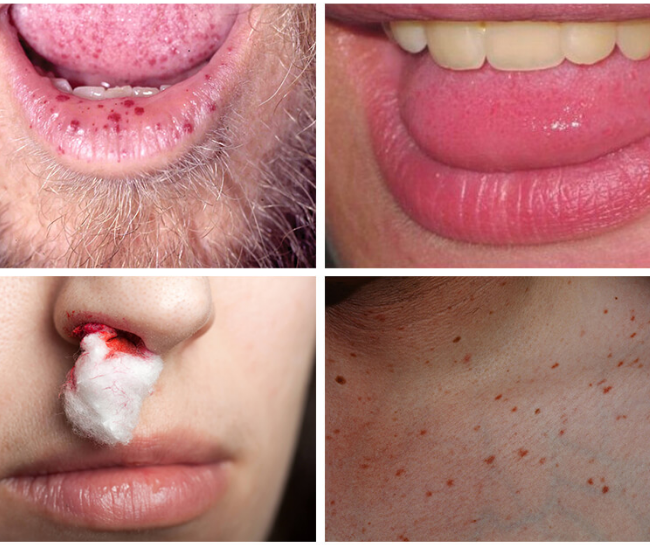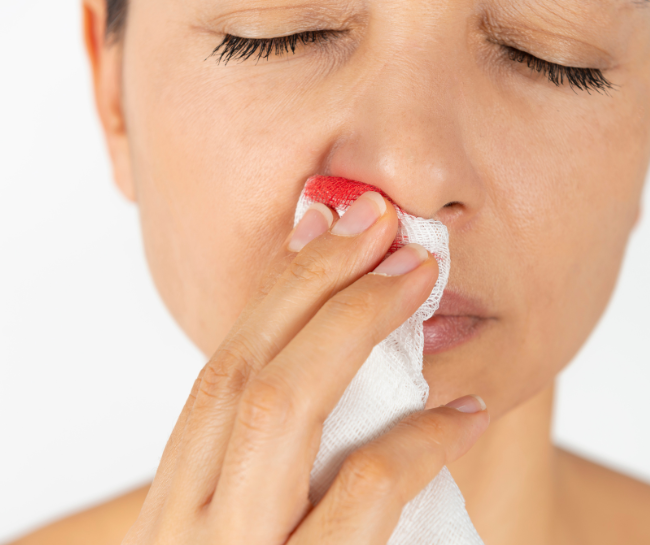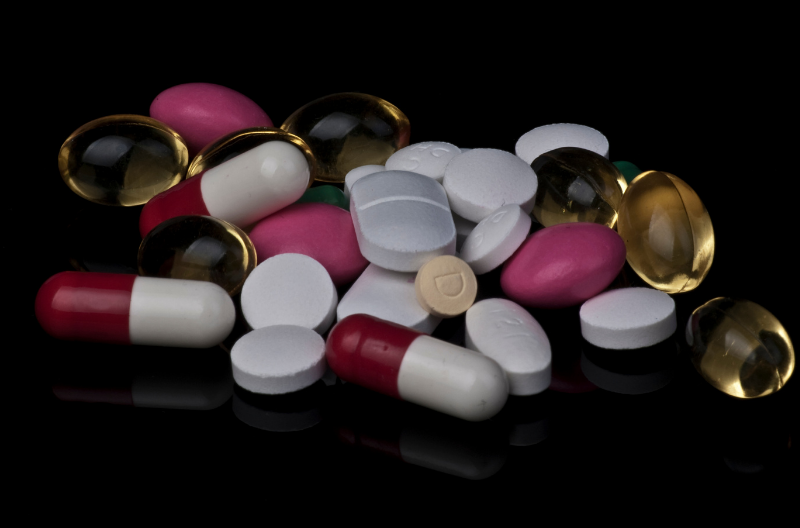Hereditary hemorrhagic telangiectasia (HHT) is a significant burden on otolaryngology practice. HHT is an autosomal dominant characteristic caused by gene abnormalities and results in nasal and gastrointestinal telangiectasia and visceral arteriovenous malformations. Recurrent epistaxis (nosebleeds) is a defining feature of HHT. It is caused by fragile nasal telangiectasia, commonly bordered by a single endothelial layer with no smooth muscle cells or pericytes while operating as blood conduits at arterial pressure. Nosebleeds are typical daily and may be related to acute hemodynamic disturbances and a worse quality of life. Epistaxis is commonly used to grade therapeutics, and many patients need more than one modality.
💡 According to research… 💡
Current iron treatments have elemental iron contents far in excess of the usual dietary daily intakes, which rarely reach 20 mg/day. This study demonstrates that for approximately 1 in 20 people with HHT, iron replacement treatments may aggravate nosebleeds.
Can Iron Treatments Aggravate Epistaxis in Some Patients with Hereditary Hemorrhagic Telangiectasia?
Epistaxis, which may be challenging to treat in clinical practice, generates extra complications. HHT patients are often iron deficient or anemic because replacing iron lost by recurrent bleeding requires extremely high iron intake. Meeting the hemorrhage-adjusted iron need by food intake alone is challenging. Iron insufficiency has a variety of negative repercussions, including anemia and transfusion needs, due to iron deficiency inhibiting erythropoiesis, resulting in low hemoglobin and lower arterial oxygen content. Iron deficiency predicts high output cardiac failure development in HHT patients with severe hepatic AVMs.

Treatment of iron deficiency and anemia in HHT patients is critical to avoid these consequences. However, we were astonished in the clinic by a small proportion of HHT patients who volunteered not to utilize iron pills or infusions to correct their iron shortage since the iron treatments induced nosebleeds within hours. This encouraged us to investigate if iron concentrations comparable to those seen in the circulation following iron tablets or infusions altered endothelial cells. Prior studies have shown that toxicity occurs at considerably greater iron concentrations, essential to iron overload syndromes or experimental endothelium models. These latest findings show that a clinically significant level of 10 M iron induces fast molecular and cellular alterations in primary human endothelial cells, consistent with the activation of DNA damage response mechanisms.
Iron treatments and HHT nosebleeds

Iron treatment often starts in adulthood, and at first glance, the iron-using group seemed to experience more nosebleeds earlier in life or as a response to stress. The population of 1,288 responders, on the other hand, was likely to contain a tiny fraction of those lacking HHT, who would have fewer nosebleeds and utilize iron less often, therefore biasing the findings. In 1,080 responders, answers to queries regarding nosebleeds, telangiectasia, and AVMs enabled the designation of HHT with perfect confidence. When analyses were limited to these 1,080 respondents, there was no difference in the percentage of iron users reporting nosebleeds during childhood or after trauma compared to nonusers, suggesting that less stringent phenotyping would have created a significant bias in this situation.
781 of the 1,080 people with a specific diagnosis of HHT reported using iron pills at some point in their lives, and 26 had received intravenous iron. Can iron supplements cause nosebleeds? Iron tablet users were more likely than non-iron tablet users to have daily nosebleeds. This was more prominent in patients who also needed intravenous iron infusions or blood transfusions, as predicted, given that recurrent nosebleeds produce iron insufficiency and the requirement for extra iron intake.
🔬 Medical research found that… 🔬
…approximately 1 in 20 people with HHT, iron replacement treatments may aggravate nosebleeds.

However, 35 of the 732 iron pill users who reported nosebleed associations said their nosebleeds were worse after taking iron tablets. Similarly, 17 of the 261 people who used intravenous iron said their nosebleeds were worse following the iron infusion; after excluding the subset of patients who had taken intravenous iron, the percentage of those reporting nosebleeds that were worse after oral iron remained identical (20 of 4420).
The proportions were compared to the percentage of people reporting nosebleed changes in response to control studies that were not predicted to affect blood vessels or serum iron levels to see whether these findings were due to methodological bias or reporting noise. Only two people reported any changes in nosebleeds after control examinations (one after a blood test, one after being weighed). Using blood tests to compare, users of iron pills and intravenous iron had a considerably greater incidence of nosebleeds that worsened following iron therapy.
Iron aggravation of nosebleeds was only reported in a subset of HHT patients. The majority of iron users reported no change in nosebleeds following iron treatments, but 56 of 732 iron tablet users and 34 of 261 iron infusion users experienced nosebleed improvement. At various times, one iron pill user experienced both benefits and exacerbations. We were worried because iron therapies seemed to increase the hemorrhagic losses they were supposed to repair occasionally.
How to deal with the adverse effects of iron supplements
Several persons report a metallic taste, nausea, constipation, stomach distress, dark-colored feces, and vomiting when taking oral iron. The following are some options for coping with these adverse effects:
- Reduce the dosage.
- Take iron with meals (although if this reduces the amount of iron absorbed by your body, it’s still healthier than not having it at all).
- Use a formulation that has fewer elements of iron (e.g., ferrous gluconate instead of ferrous sulfate)
- Increase the ferrous sulfate dosage in a liquid state until effects are manageable.
- Change to intravenous iron therapy
When should I be concerned about a nosebleed

A nosebleed may be frightening, mainly if it occurs in your kid. While nosebleeds might arise out of nowhere, most aren’t significant and can be treated at home. Numerous blood arteries run along the surface of your nose, and even the tiniest damage or irritation may cause bleeding.
Most adults and children will have a nosebleed at some point in their life. After several minutes of self-care, the bleeding will usually cease. A nosebleed in your kid is frightening. However, bear in mind that nosebleeds are relatively frequent among youngsters. This isn’t to say that you should disregard every nosebleed.
You’ll see blood dripping or flowing from your child’s nose if they have a mild nosebleed. They may bleed from one or both nostrils. The bleeding may be stopped with immediate home care.
Therefore, you should see a doctor if any of the following apply:
- When nosebleeds do not cease after 20 minutes of direct pressure, particularly if your kid has a head or facial injury, severe damage to the nose or skull is possible.
- A foreign item has been lodged in your child’s nostril.
- Additional symptoms your kid is experiencing include dizziness, headaches, exhaustion, vomiting, and difficulty breathing. This might mean they’ve lost a lot of blood or have blood pouring down their mouth.
Thanks for reading, any thoughts about this article? Leave it in the comment section 💖

